Hidden away from sight in a side room next to an underground car park is one of the more important remains of the old London Wall that actually dates from before the wall was built.
When the Romans first started to settle in London (Londinium), a garrison fort was built to the North West of the town. Built with stone walls, it is thought to have had four gates and a barracks for around 1,000 soldiers.
When the London Wall was built around 80 years later, two sides of the fort were incorporated into the Wall and strengthened. Eventually, the two inner walls of the fort were lost, leaving just the London Wall with its famous gates. The northern gate into the former fort became known as Cripplegate.
However, the western gate was lost to history for some reason, and wasn’t rediscovered until the 1950s.
It was to see the remains of this gate that had me wandering over the Museum of London for one of their occasional tours of the site.
Next to the museum – as I am sure you know – are some remains of the London Wall, although most of what you see is actually medieval and Victorian repairs to the wall. King Henry II add the towers and the Victorians used the wall as a “free” fourth wall for warehouses to cut down on building costs.
What we were to see though is totally Roman.
Going down the ramp that runs next to the wall – and avoiding the taxi driving the wrong way down a one-way street, there is a rather nondescript alley under the road leading to the car park, where you might notice a locked door marked private.
In here lies the remains of the Western gatehouse.
A rather musty smell inside adds to the atmosphere, but is due to the rainwater drains in the road above leaking into the room, and is nothing to do with the ruins themselves.
What has been excavated is part of the wall, the gatehouse and the remains of part of the arches that marked the entrance to the fort itself.
The gatehouse had two arches – presumably one side for inbound traffic and the other for outbound – but for some reason, one of the arches was blocked off at some point very early in its history. It is possible that the blocking of the gate is part of the reason why it never became one of the city’s major gates – Ludgate, Newgate, Aldersgate, Cripplegate, Moorgate, Bishopsgate, and Aldgate, although no one is really sure about this.
We were also shown the post hole which would have held the upright pole that hinged the main gates as well as the flat runner for the portcullis.
Also noticeable is the entry stone for the gatehouse, which has been worn down by people walking over it. The two groves are probably from two bolts that went down into a hole in the stone to lock the doors. Over time, the bolts carved out a groove in the stone.
Although the fort was made of stone walls, it was not a castle-grade fortification as the walls were quite thin. Romans preferred to fight in the fields rather than engage in sieges. However, when the London Wall was later built, it was much thicker, and you can see the gap between the fort wall (left) and the substantial works added to strengthen the wall (right).
Apart from this small room with old stones, there isn’t a lot to see, but it is still one of the more important Roman remains in situ within the City and worth spending half an hour visiting.
The visit also means I can tick off one more item from my list of Subterranean London places I want to visit.
The next tours are Sept 15th; Oct 19th; Nov 18th and Dec 15th. Tours are free and limited to 20 people. Collect a ticket from the main desk inside the museum about 10 minutes before the tour starts. Tours are at 2:30pm and 3:30pm.
I’ve also rather cheekily scanned in a sheet they handed out as I think it is rather good:
The part of the fort we went to see is the dark red line that runs right under the modern London Wall road.

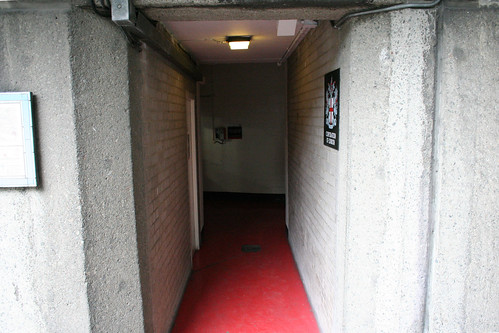
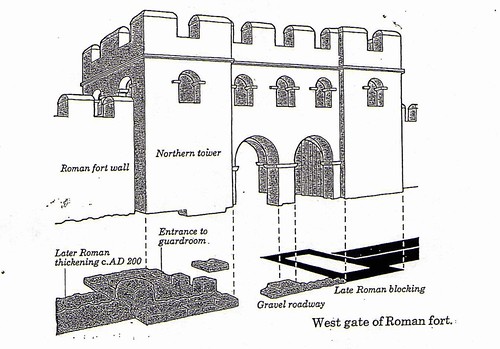
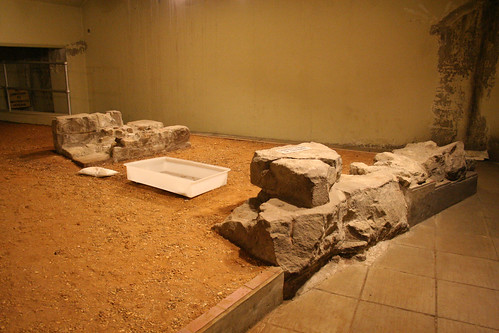
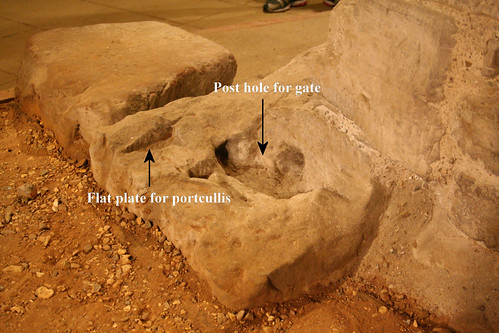
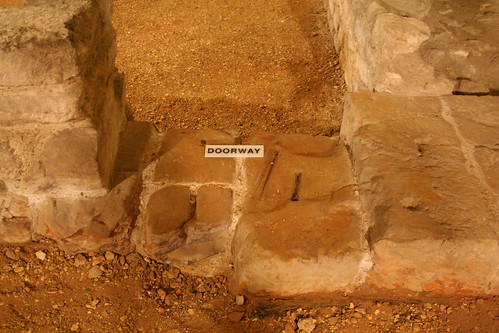

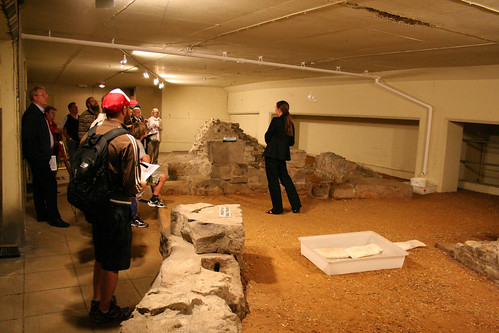
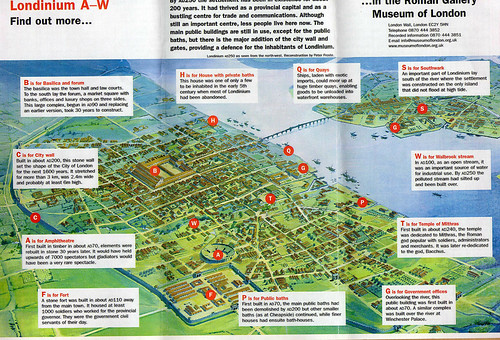
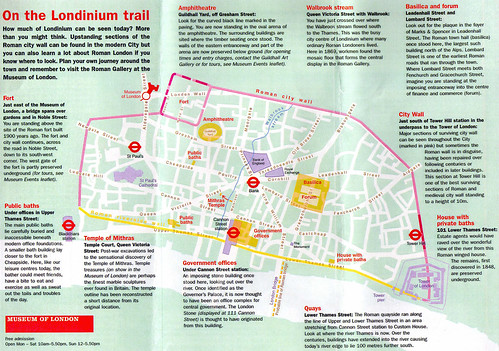






Hi Ian,
Planning a three day trip to London with two boys and a husband, 10, 7 & 40! Any pointers; one has been studying The Tudors and the other The Great Fire. Already put the Museum of London on our list courtesy of Michelle Dent and have hampton court palace and the tower of london in our sights. Anything that you think would enhance the visit (apart from a stiff gin of an evening)!
Karen
I was on the same trip! Unless with the naughty taxi and the man with the big beard were coincidences. I would’ve said hello if i’d recognised you…
Super write-up. But i think the delightful guide deserves a mention 🙂
Karen – i think the 3 things you’ve mentioned could easily fill 3 days!
If you’ve got any spare time then the British Museum is well worth a look. Also, perhaps worth noting that the two museums (London & British) are both free.
Karen –
The Monument is worth a visit at a couple of quid and will be a welcome break from all the museums! It’s the monument to the fire of London, built the distance of its height away from the outbreak of the fire on Pudding Lane. You get to walk up the column to get a good view from the top. It’s all the more impressive when you consider how big it was relevative to its surroundings when it was built (http://upload.wikimedia.org/wikipedia/commons/1/10/London_Bridge_engraved_by_J.Woods_after_Hablot_Browne_%26_R.Garland_publ_1837_edited.jpg).
The Sir John Soane museum is a delightful way to spend an hour or 2 – it’s on Lincoln’s Inn Fields, near Holborn tube.
To the south side of Lincoln’s Inn Fields is the Hunterian Museum (in the Royal College of Surgeons) full of medical oddities and specimens, if your lads are craving the ‘euuuuw’ factor!
Whilst you’re around the British Museum area, a good pub is the Princess Louise on High Holborn – A beautiful old gin palace which is a Samuel Smith (= v cheap beer) pub to boot! Gorgeous men’s old bathrooms as well (the door signs aren’t very clear – oops!).
You might want to go ‘mudlarking’ – Walking on the foreshore at low tide – There are steps down to the ‘beaches’ with the best areas being either side of the Millennium footbridge – Great fun for the kids to pick up all sorts of Sawyer-esque ‘treasure’.
A trip on the river is always fun too – you could take the boat out to Hampton Court.
If you end up in Greenwich at all, make sure you take a trip through the Thames Foot Tunnel by the Cutty Sark – Nothing quite like the uneasiness of walking along an old, cold (yet in frequent use!) tunnel with the Thames above you!
Also, if you go to any park or square (there are several around the BM, for instance) try to make sure you have some monkey nuts/ peanuts on you as you can get squirrels to take them from your hand, which is always good fun 🙂
The most important thing to remember on your trip is to remember that the tube map is stylised and the distances between stops can be much longer or shorter than they appear – It is frequently quicker to walk!
What a fantastic find – I know all about the Roman Amphitheatre underneath the Art Gallery at Guildhall but I wasn’t aware that this even existed. I’ll have to pay it a visit (and the London museum, which I haven’t been to in forever)
The Temple of Mithras on Queen Victoria is worth a visit. In the 1960’s it was discovered and moved to its current site due to the construction of a tower block. That block has now been demolished and its replacement will contain the temple restored to its origional location.
Travelling to London June 2016 as part working vacation (for me) and part homeschooling fieldtrip (age 11 and 14)for my children. Is there a way (person to contact, etc) to arrange for underground Roman tours? TY.